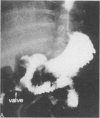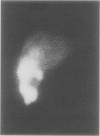Abstract
Forty-six consecutive patients with biliary atresia were operated on at our institution during the 11-year period between 1978 and 1989. Their ages at operation ranged from 18 to 153 days (mean, 59 days). After dissecting the porta hepatis structures by Kasai operation, a biliointestinal anastomosis was constructed with a valved hepatic portoduodenal intestinal conduit in all cases. The intestinal valve is an intussuscepted muscular valve. Valvular function was examined radiologically. The upper gastrointestinal series demonstrated no reflux of contrast material into the conduit proximal to the valve and liver scintigraphy demonstrated that radioactive isotope drained readily into the duodenum through the valve. Thirty-nine of the forty-six patients (85%) had bile drainage after initial operation. At present 30 patients (65%) are alive without jaundice, 6 (13%) are alive with jaundice, and 10 (22%) are dead. The 5-year jaundice-free survival rate was 64%. Cholangitis occurred in 9 of 39 patients (23%) who had obtained apparent bile drainage: 5 had tractable cholangitis and 4 had refractory cholangitis. Reoperation restored bile flow in 2 of 8 patients who abruptly ceased to have bile drainage without cholangitis. In conclusion, with a valved hepatic portoduodenal intestinal conduit, the incidence of cholangitis was decreased, its medical control became easier, and the survival rate was improved.
Full text
PDF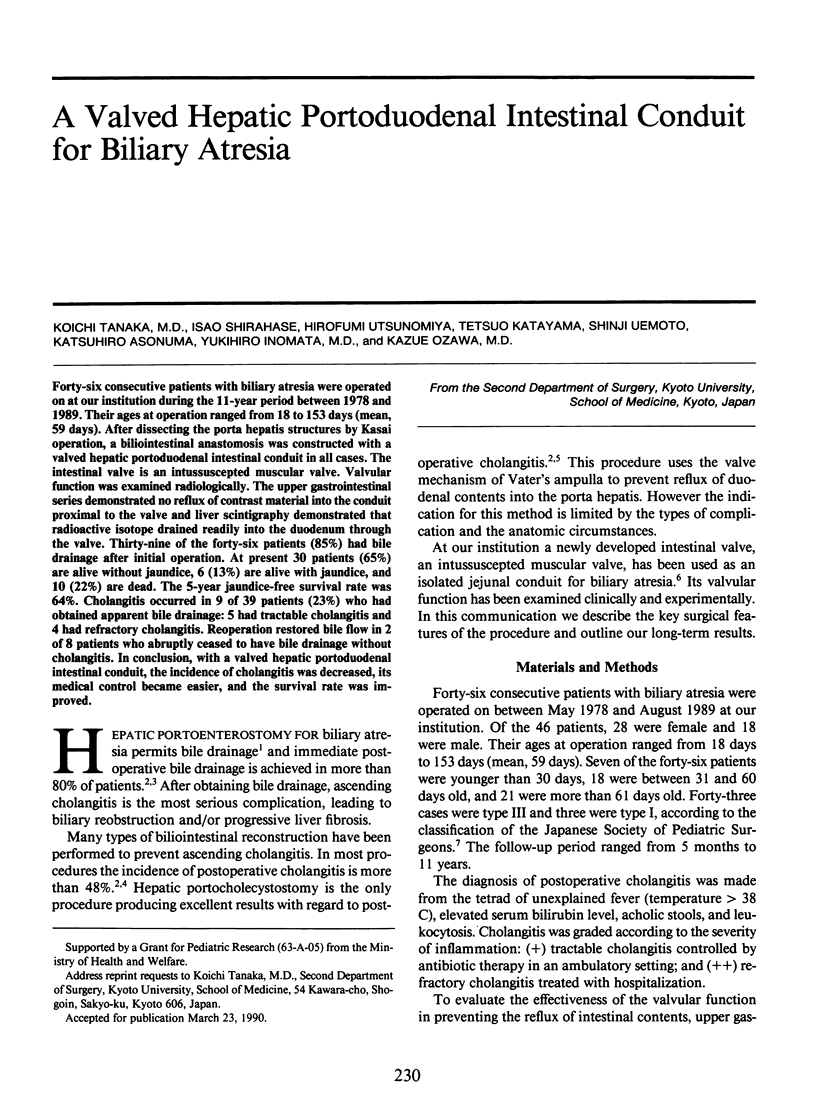
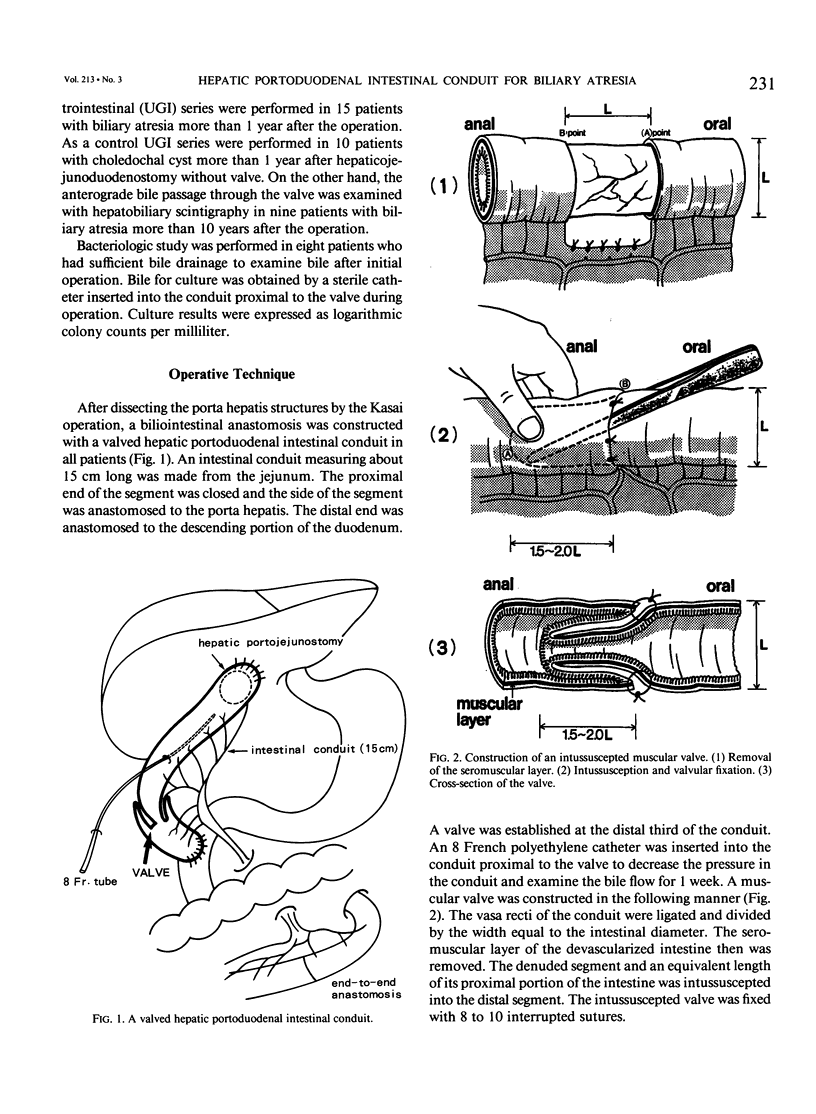
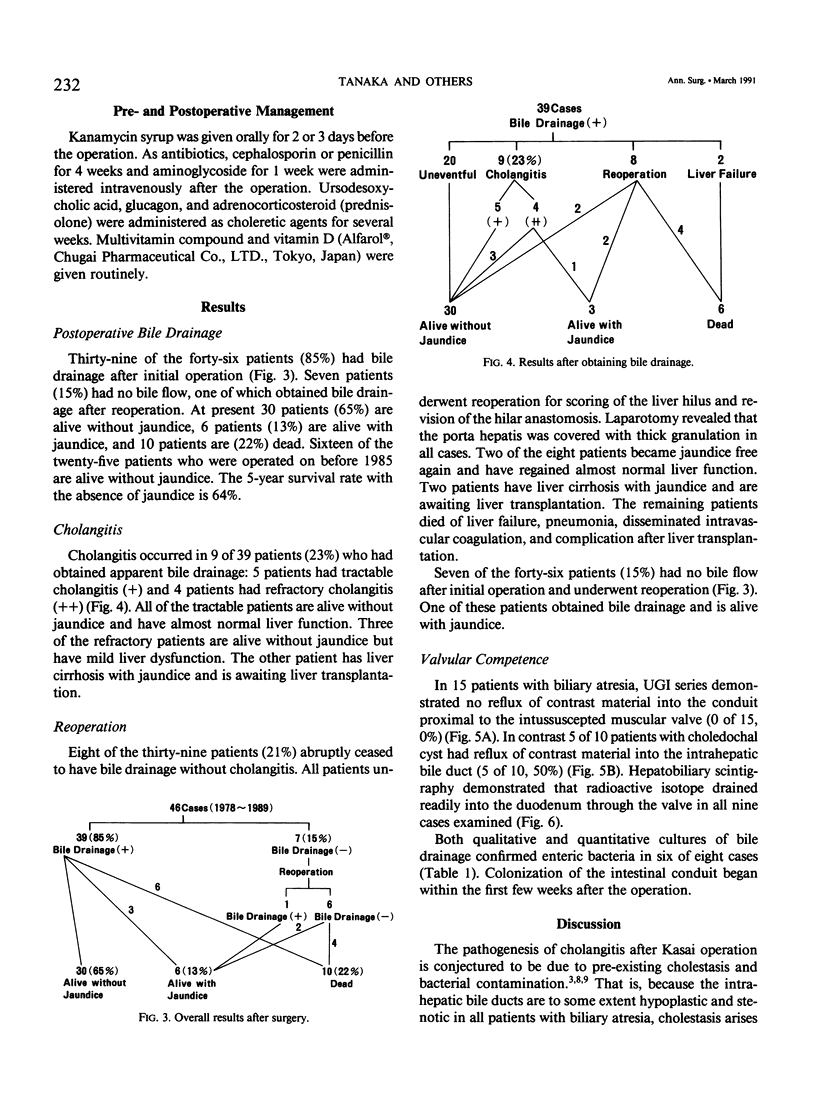
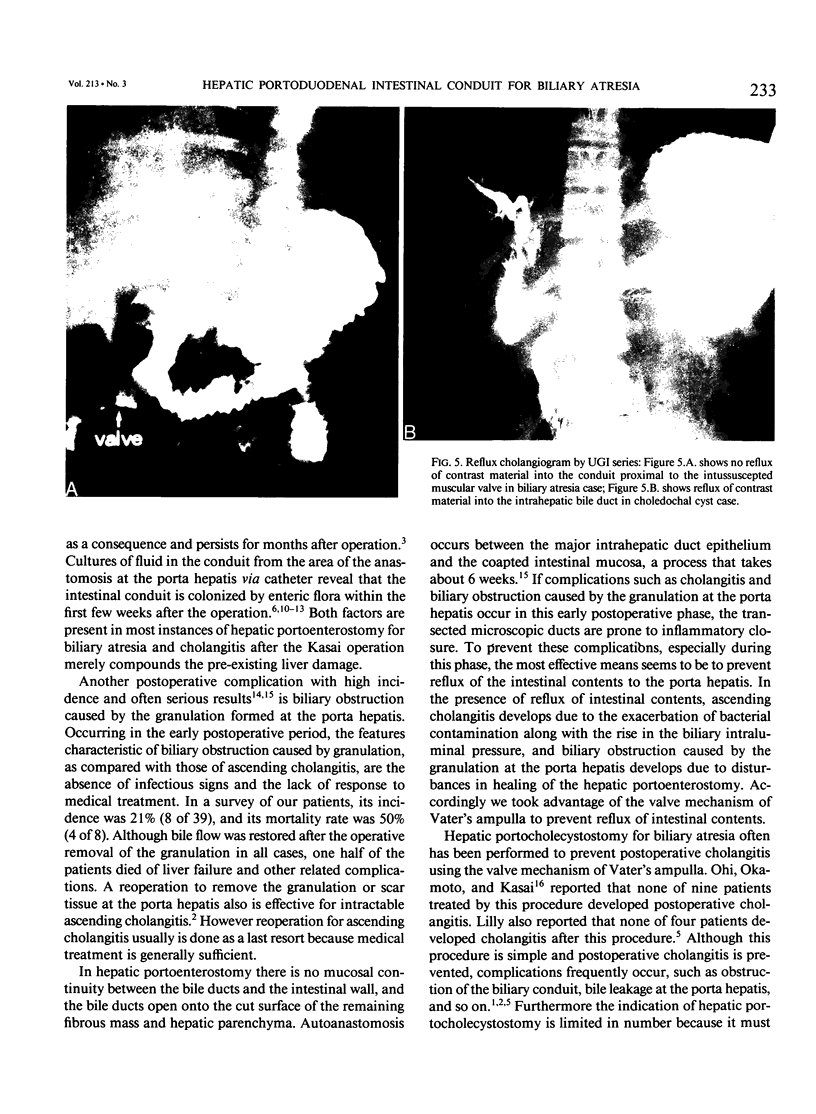
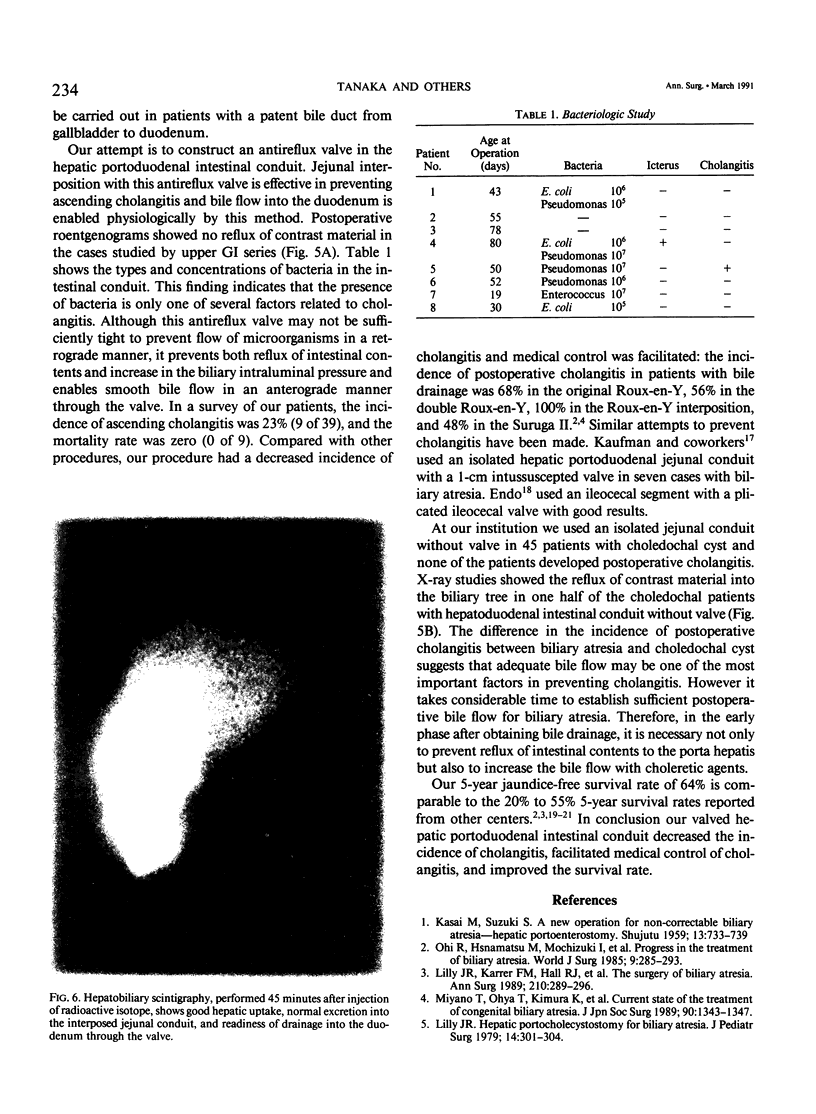
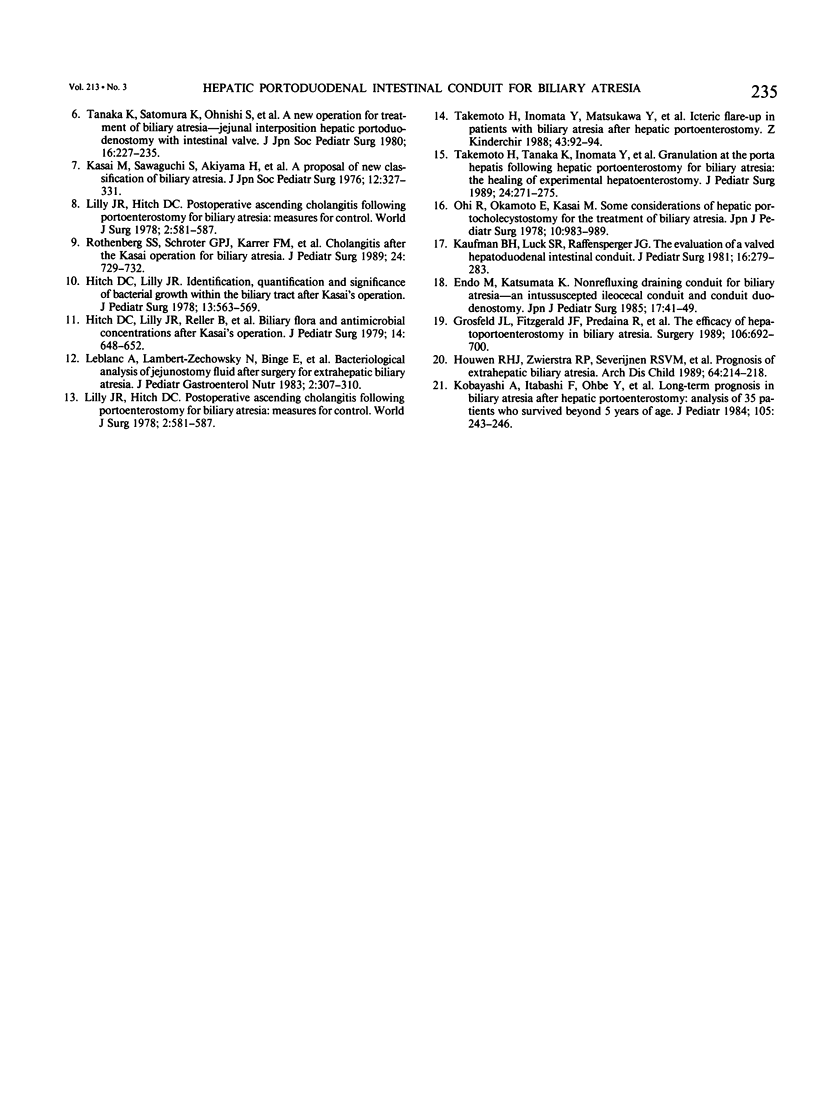
Images in this article
Selected References
These references are in PubMed. This may not be the complete list of references from this article.
- Grosfeld J. L., Fitzgerald J. F., Predaina R., West K. W., Vane D. W., Rescorla F. J. The efficacy of hepatoportoenterostomy in biliary atresia. Surgery. 1989 Oct;106(4):692–701. [PubMed] [Google Scholar]
- Hitch D. C., Lilly J. R. Identification, quantification, and significance of bacterial growth within the biliary tract after Kasai's operation. J Pediatr Surg. 1978 Dec;13(6D):563–569. doi: 10.1016/s0022-3468(78)80094-3. [DOI] [PubMed] [Google Scholar]
- Hitch D. C., Lilly J. R., Reller L. B., Lauer B. A. Biliary flora and antimicrobial concentrations after Kasai's operation. J Pediatr Surg. 1979 Dec;14(6):648–652. doi: 10.1016/s0022-3468(79)80238-9. [DOI] [PubMed] [Google Scholar]
- Houwen R. H., Zwierstra R. P., Severijnen R. S., Bouquet J., Madern G., Vos A., Bax N. M., Heymans H. S., Bijleveld C. M. Prognosis of extrahepatic biliary atresia. Arch Dis Child. 1989 Feb;64(2):214–218. doi: 10.1136/adc.64.2.214. [DOI] [PMC free article] [PubMed] [Google Scholar]
- Kaufman B. H., Luck S. R., Raffensperger J. G. The evolution of a valved hepatoduodenal intestinal conduit. J Pediatr Surg. 1981 Jun;16(3):279–283. doi: 10.1016/s0022-3468(81)80680-x. [DOI] [PubMed] [Google Scholar]
- Kobayashi A., Itabashi F., Ohbe Y. Long-term prognosis in biliary atresia after hepatic portoenterostomy: analysis of 35 patients who survived beyond 5 years of age. J Pediatr. 1984 Aug;105(2):243–246. doi: 10.1016/s0022-3476(84)80120-1. [DOI] [PubMed] [Google Scholar]
- Leblanc A., Lambert-Zechovsky N., Bingen E., Proux M. C., Odièvre M. Bacteriological analysis of jejunostomy fluid after surgery for extrahepatic biliary atresia. J Pediatr Gastroenterol Nutr. 1983 May;2(2):307–310. [PubMed] [Google Scholar]
- Lilly J. R. Hepatic portocholecystostomy for biliary atresia. J Pediatr Surg. 1979 Jun;14(3):301–304. doi: 10.1016/s0022-3468(79)80487-x. [DOI] [PubMed] [Google Scholar]
- Lilly J. R., Hitch D. C. Postoperative ascending cholangitis following portoenterostomy for biliary atresia: measures for control. World J Surg. 1978 Sep;2(5):581–585. doi: 10.1007/BF01556050. [DOI] [PubMed] [Google Scholar]
- Lilly J. R., Hitch D. C. Postoperative ascending cholangitis following portoenterostomy for biliary atresia: measures for control. World J Surg. 1978 Sep;2(5):581–585. doi: 10.1007/BF01556050. [DOI] [PubMed] [Google Scholar]
- Lilly J. R., Karrer F. M., Hall R. J., Stellin G. P., Vasquez-Estevez J. J., Greenholz S. K., Wanek E. A., Schroter G. P. The surgery of biliary atresia. Ann Surg. 1989 Sep;210(3):289–296. doi: 10.1097/00000658-198909000-00004. [DOI] [PMC free article] [PubMed] [Google Scholar]
- Miyano T., Ohya T., Kimura K., Arai T., Shimomura H., Yamataka A., Fukunaga K. [Current state of the treatment of congenital biliary atresia]. Nihon Geka Gakkai Zasshi. 1989 Sep;90(9):1343–1347. [PubMed] [Google Scholar]
- Ohi R., Hanamatsu M., Mochizuki I., Chiba T., Kasai M. Progress in the treatment of biliary atresia. World J Surg. 1985 Apr;9(2):285–293. doi: 10.1007/BF01656322. [DOI] [PubMed] [Google Scholar]
- Rothenberg S. S., Schroter G. P., Karrer F. M., Lilly J. R. Cholangitis after the Kasai operation for biliary atresia. J Pediatr Surg. 1989 Aug;24(8):729–732. doi: 10.1016/s0022-3468(89)80525-1. [DOI] [PubMed] [Google Scholar]
- Takemoto H., Inomata Y., Matsukawa Y., Tanaka K., Satomura K., Ozawa K. Icteric flare-up in patients with biliary atresia after hepatic portoenterostomy. Z Kinderchir. 1988 Apr;43(2):92–94. doi: 10.1055/s-2008-1043424. [DOI] [PubMed] [Google Scholar]
- Takemoto H., Tanaka K., Inomata Y., Matsukawa Y., Satomura K., Ozawa K. Granulation at the porta hepatis following hepatic portoenterostomy for biliary atresia: the healing of experimental hepatoenterostomy. J Pediatr Surg. 1989 Mar;24(3):271–275. doi: 10.1016/s0022-3468(89)80011-9. [DOI] [PubMed] [Google Scholar]



